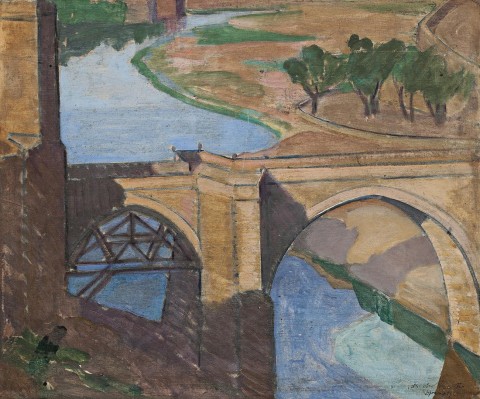BRIDGE IN SPAIN (ALCÁNTARA BRIDGE, TOLEDO), 1925
ROY DE MAISTRE
oil on board
38.0 x 46.0 cm
signed, dated and inscribed lower right: R. de Mestre / Spain 1925
bears inscription verso: … bridge To… / 23
Joseph Brown Gallery, Melbourne
Ken and Joan Plomley Collection of Modernist Art, Melbourne, acquired from the above in April 1979
probably: R. de Mestre, Macquarie Galleries, Sydney, 11 – 21 July 1928, cat. 6 (as ‘Sketch – Alcantara Bridge, Toledo’)
Autumn Exhibition 1979, Joseph Brown Gallery, Melbourne, 5 – 20 April 1979, cat. 78 (illus. in exhibition catalogue as ‘Spain, 1925’)
Johnson, H., Roy de Maistre: The Australian Years 1894-1930, Craftsman House, Sydney, 1988, pl. 16, pp. 49, 53 (illus. as ‘Bridge in Spain’)
Alcantara Bridge, Toledo, exhibited in The Burdekin House Exhibition, 1929, illus. in Edwards, D., and Mimmocchi, D. (eds.), Sydney Moderns: Art for a New World, exhibition catalogue, Art Gallery of New South Wales, Sydney, 2013, p. 129
In 1923, Roi de Mestre (as he then spelled his name) was awarded the Society of Artists Travelling Scholarship and journeyed to Europe. One of the paintings he entered for the award was Still life, c.1922, a moody rendering of white blooms painted in the manner of the ‘tonalist’ artist Max Meldrum. De Maistre, and his colleague Roland Wakelin, studied with the controversial Meldrum for a year following their landmark exhibition Colour in Art held in Sydney in 1919. Presented as a high-coloured, modernist vision, that exhibition polarised opinion within the small community of local art buyers and, sensitive to such rebuttals, the two men sought to continue their painterly research by studying with Meldrum. In Bridge in Spain (Alcántara Bridge, Toledo), 1925, de Maistre’s attempts to reconcile such divergent theories is made apparent.
Travelling first to London where he is presumed to have seen a major exhibition by Van Gogh at the Leicester Galleries, de Maistre found himself disappointed by the quality of English light, even though he had arrived late in the northern Summer. Seeking alternate inspiration, he travelled to Paris (see lot 4 Paysage Automne (in the Luxembourg Gardens)), Arles and Compiègne in France, before renting a studio for three months in the Basque resort of St. Jean de Luz in 1925.1 He also exhibited one work in the 1924 Société Nationale des Beaux Arts in Paris though this painting Nature mort, known only through black-and-white reproduction, appears to follow the tonal realism taught by Meldrum. Following his arrival in St. Jean de Luz, colour re-appears in de Maistre’s paintings as does evidence of exploratory phases into new realms of depiction, which, as his biographer Heather Johnson notes, ‘hint at the ‘cubist’ style of de Maistre’s later work’.2
In Bridge in Spain (Alcántara Bridge, Toledo) de Maistre’s focus is on the western tower and arches of the Puente de Alcántara which spans the Tagus River in Toledo, Spain. Built of stone, it was constructed on orders of the Roman emperor Trajan between the years 104 and 106 AD. De Maistre’s painting looks toward the eastern shore where patches of trees and parkland remain to this day. Then, as now, the bridge is a place of strong tourist interest, as evident by the artist’s portrait of an enterprising local street musician in the related lot 3 Figure with Guitar. De Maistre maintains a looseness to his brushwork in this painting, which sets off a visual rhythm as the strokes play in opposition to the more considered, evenly flattened passages which articulate the bridge itself. The curves of the two arches rhyme with those of the continuing riverbank, the small stand of trees and the ascending road in the upper right of the landscape. Although subtle, de Maistre’s celebration of colour is evident in the greens, blues and purples which punctuate the dominant warmth of the ochre. It is a considered painting full of existing strengths combined with unabashed painterly doubt, evidence of a maturing artist confidently seeking new ways to articulate his vision of the world around him.
1. See Johnson, H., Roy de Maistre: The Australian Years 1894-1930, Craftsman House, Sydney, 1988, pp. 42, 46
2. Johnson, H., op cit., p. 49
ANDREW GAYNOR
